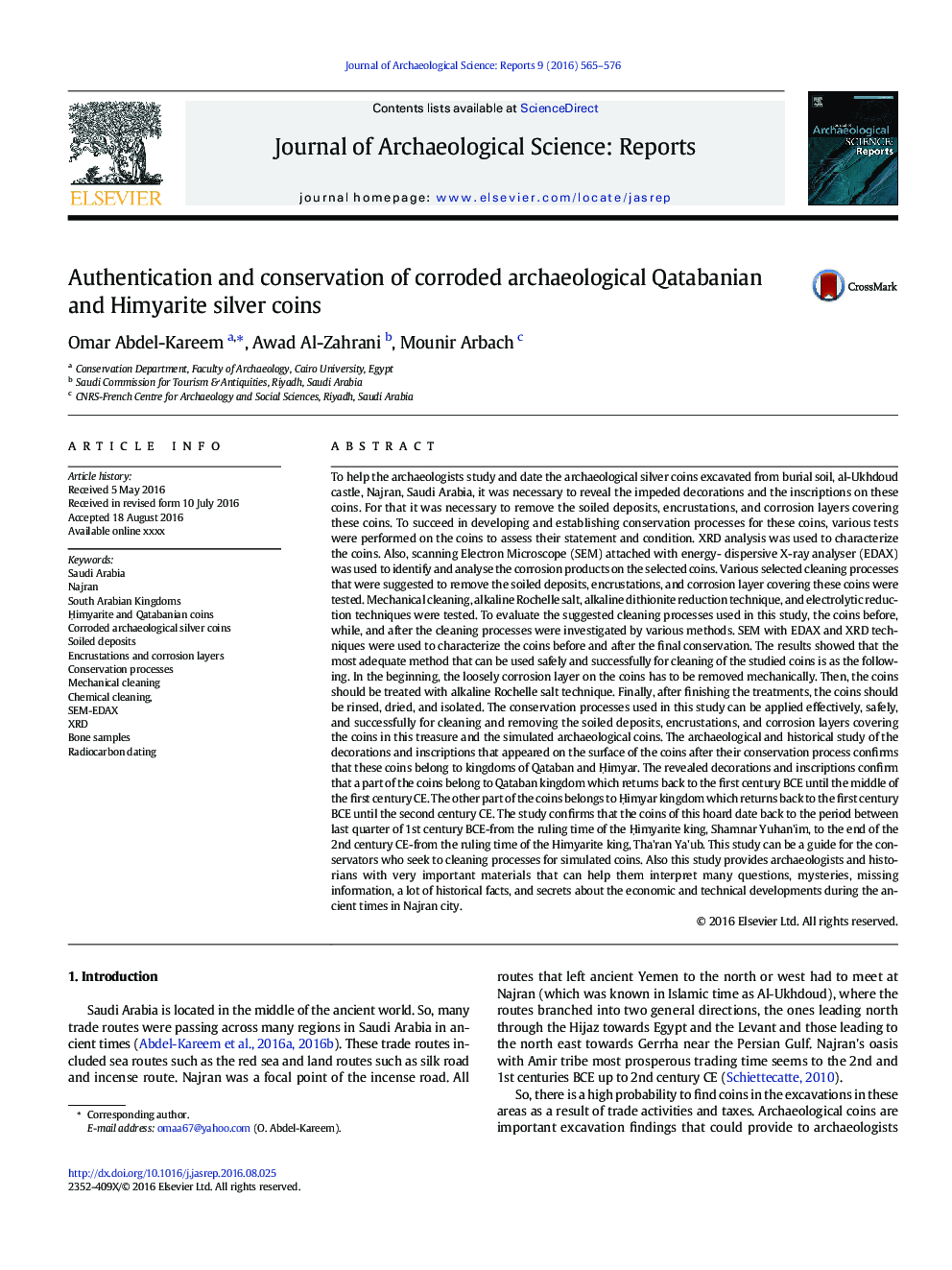| کد مقاله | کد نشریه | سال انتشار | مقاله انگلیسی | نسخه تمام متن |
|---|---|---|---|---|
| 7445660 | 1483934 | 2016 | 12 صفحه PDF | دانلود رایگان |
عنوان انگلیسی مقاله ISI
Authentication and conservation of corroded archaeological Qatabanian and Himyarite silver coins
دانلود مقاله + سفارش ترجمه
دانلود مقاله ISI انگلیسی
رایگان برای ایرانیان
کلمات کلیدی
موضوعات مرتبط
علوم انسانی و اجتماعی
علوم انسانی و هنر
تاریخ
پیش نمایش صفحه اول مقاله

چکیده انگلیسی
To help the archaeologists study and date the archaeological silver coins excavated from burial soil, al-Ukhdoud castle, Najran, Saudi Arabia, it was necessary to reveal the impeded decorations and the inscriptions on these coins. For that it was necessary to remove the soiled deposits, encrustations, and corrosion layers covering these coins. To succeed in developing and establishing conservation processes for these coins, various tests were performed on the coins to assess their statement and condition. XRD analysis was used to characterize the coins. Also, scanning Electron Microscope (SEM) attached with energy- dispersive X-ray analyser (EDAX) was used to identify and analyse the corrosion products on the selected coins. Various selected cleaning processes that were suggested to remove the soiled deposits, encrustations, and corrosion layer covering these coins were tested. Mechanical cleaning, alkaline Rochelle salt, alkaline dithionite reduction technique, and electrolytic reduction techniques were tested. To evaluate the suggested cleaning processes used in this study, the coins before, while, and after the cleaning processes were investigated by various methods. SEM with EDAX and XRD techniques were used to characterize the coins before and after the final conservation. The results showed that the most adequate method that can be used safely and successfully for cleaning of the studied coins is as the following. In the beginning, the loosely corrosion layer on the coins has to be removed mechanically. Then, the coins should be treated with alkaline Rochelle salt technique. Finally, after finishing the treatments, the coins should be rinsed, dried, and isolated. The conservation processes used in this study can be applied effectively, safely, and successfully for cleaning and removing the soiled deposits, encrustations, and corrosion layers covering the coins in this treasure and the simulated archaeological coins. The archaeological and historical study of the decorations and inscriptions that appeared on the surface of the coins after their conservation process confirms that these coins belong to kingdoms of Qataban and Ḥimyar. The revealed decorations and inscriptions confirm that a part of the coins belong to Qataban kingdom which returns back to the first century BCE until the middle of the first century CE. The other part of the coins belongs to Ḥimyar kingdom which returns back to the first century BCE until the second century CE. The study confirms that the coins of this hoard date back to the period between last quarter of 1st century BCE-from the ruling time of the Ḥimyarite king, Shamnar Yuhan'im, to the end of the 2nd century CE-from the ruling time of the Himyarite king, Tha'ran Ya'ub. This study can be a guide for the conservators who seek to cleaning processes for simulated coins. Also this study provides archaeologists and historians with very important materials that can help them interpret many questions, mysteries, missing information, a lot of historical facts, and secrets about the economic and technical developments during the ancient times in Najran city.
ناشر
Database: Elsevier - ScienceDirect (ساینس دایرکت)
Journal: Journal of Archaeological Science: Reports - Volume 9, October 2016, Pages 565-576
Journal: Journal of Archaeological Science: Reports - Volume 9, October 2016, Pages 565-576
نویسندگان
Omar Abdel-Kareem, Awad Al-Zahrani, Mounir Arbach,